University of Canterbury
The University of Canterbury (UC; Māori: Te Whare Wānanga o Waitaha; postnominal abbreviation Cantuar. or Cant. for Cantuariensis, the Latin name for Canterbury) is a public research university based in Christchurch, New Zealand. It was founded in 1873 as Canterbury College, the first constituent college of the University of New Zealand. It is New Zealand's second-oldest university, after the University of Otago, which was founded four years earlier, in 1869.
Te Whare Wānanga o Waitaha | |
 Coat of arms | |
Former names | Canterbury College |
|---|---|
| Motto | (Unofficial) Latin: Ergo tua rura manebunt |
Motto in English | Therefore may your fields prosper (or: remain unto you) |
| Type | Public research university |
| Established | 1873 |
Academic affiliation | |
| Endowment | NZD $142 million (2022)[1] |
| Budget | NZD $417.7million (31 December 2020)[2] |
| Chancellor | Amy Adams |
| Vice-Chancellor | Cheryl de la Rey |
Academic staff | 867 (2020)[2] |
Administrative staff | 1,395 (2020)[2] |
| Students | 21,361 (March 2023)[2] |
| Undergraduates | 12,224 (2020)[2] |
| Postgraduates | 3,154 (2020)[2] |
| Location | , New Zealand (Maori: Ōtautahi, Aotearoa) 43°31′24″S 172°34′55″E |
| Campus | Suburban and Urban 87 hectares (210 acres) |
| Language | English and Māori |
| Student Magazine | Canta |
| Colours | UC Murrey Red and UC Gold[3]
|
| Affiliations | |
| Website | www |
Its original campus was in the Christchurch Central City, but in 1961 it became an independent university and began moving out of its original neo-gothic buildings, which were re-purposed as the Christchurch Arts Centre. The move was completed on 1 May 1975[6] and the university now operates its main campus in the Christchurch suburb of Ilam.
The university is well known for its Engineering and Science programmes, with its Civil Engineering programme ranked 9th in the world (Academic Ranking of World Universities, 2021).[7] The university also offers a wide range of other courses including degrees in Arts, Commerce, Education (physical education), Fine Arts, Forestry, Health Sciences, Law, Criminal Justice, Antarctic Studies, Music, Social Work, Speech and Language Pathology, Sports Coaching and Teaching.
History
Canterbury College, University of New Zealand, 1873–1960
On 16 June 1873, the university was founded in the centre of Christchurch as Canterbury College, the first constituent college of the University of New Zealand and was funded by the then Canterbury Provincial Council. It became the second institution in New Zealand providing tertiary-level education (following the University of Otago, established in 1869), and the fourth in Australasia.[8] It was founded on the basis of the Oxbridge college system, but it differed from Oxbridge in that it admitted female students from its foundation. Its foundation professors arrived in 1874, namely, Charles Cook (Mathematics, University of Melbourne, St John's College, Cambridge), Alexander Bickerton (Chemistry and Physics, School of Mining, London), and John Macmillan Brown (University of Glasgow, Balliol College, Oxford).[9] A year later the first lectures began and in 1875 the first graduations took place. In 1880, Helen Connon was the first woman to graduate from the college, and in 1894, Apirana Ngata became the first Māori-born student to graduate with a degree.[10] The School of Art was founded in 1882, followed by the faculties of Arts, Science, Commerce, and Law in 1921, and Mental, Moral, and Social Sciences in 1924. The Students' Union, now known as the University of Canterbury Students Association, was founded in 1929 operating out of the Arts Centre of Christchurch Old Student Union Building, and the first edition of the student magazine Canta was published in 1930. In 1933, the name changed from Canterbury College to Canterbury University College.
College House, a student dormitory that maintains its old tradition by adopting the Oxbridge college system, broke away from Christ's College in 1957 and relocated to the Ilam suburb of Christchurch in 1966 as a hall of residence at the University of Canterbury.[11] In 1957 the name changed again to the University of Canterbury.[12]
Independence of the University of Canterbury, 1961–2010
Until 1961, the university formed part of the University of New Zealand (UNZ), and issued degrees in its name. That year saw the dissolution of the federal system of tertiary education in New Zealand, and the University of Canterbury became an independent University awarding its own degrees. Upon the UNZ's demise, Canterbury Agricultural College became a constituent college of the University of Canterbury, as Lincoln College.[13] Lincoln College became independent in 1990 as a full university in its own right and is now known as Lincoln University.[14]
Coat of arms
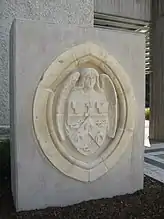
With the dissolution of the University of New Zealand, the newly independent University of Canterbury devised its own coat of arms, blazoned: "Murrey a fleece argent, in base a plough or, and on a chief wavy or an open book proper bound murrey, edged and clasped or between a pall azure charged with four crosses formy fitchy or and a cross flory azure."
An explanation of the arms appears on the university website, where it is explained that the fleece symbolises the pastoral, and the plough at the base the agricultural background of the province of Canterbury. The bishop's pall and the cross flory represent Canterbury's ecclesiastical connections, and the open book denotes scholarship.[15]
As an institution of learning, the university's coat of arms does not have a helmet, crest or mantling.
The university's unofficial coat of arms was accompanied by the Latin motto "Ergo tua rura manebunt," which means "therefore may your fields prosper" (or: "remain unto you"). Because of the land holdings with which the Provincial Government endowed the early University, this was appropriate. When the coat of arms was redesigned, the motto was removed and now the motto is only used unofficially.
Relocation to Ilam campus
Over the period from 1961 to 1974, the university campus relocated from the centre of the city to its much larger current site in the suburb of Ilam. 1973 saw the university celebrate its centenary, during which the neo-gothic buildings of the old campus were gifted to the City of Christchurch, which became the site of the Christchurch Arts Centre, a hub for arts, crafts and entertainment in Christchurch.[16] 1974 also marked the opening of the James Hight Library, which at the time, was New Zealand's largest university building. Ilam's three university halls of residence were renamed University Hall in 1974, and the student dormitory was used as the Athletes Village dormitory for the 1974 British Commonwealth Games hosted in Christchurch.[17]
In 2004, the university underwent restructuring into four Colleges and a School of Law, administering a number of schools and departments (though a number of departments have involvement in cross-teaching in numerous academic faculties). For many years the university worked closely with the Christchurch College of Education, leading to a full merger in 2007, establishing a fifth College.[18]
Post-earthquakes, 2010–present
On 4 September 2010 at 4:35 am local time an earthquake struck the South Island of New Zealand with a moment magnitude of 7.1 several aftershocks followed the main event, the strongest of which was a magnitude 6.3 shock known as the Christchurch earthquake that occurred nearly six months later on 22 February 2011.[19] Although there was no serious injuries to staff or students on campus and only minor damage to buildings, the initial quake closed the university for a week, and the library was shut for months while shelves were repaired and half a million books placed back on shelves.[20] The Student Volunteer Army was a group of around 10,000 university students and others who worked over a period of months to help clean up liquefaction.[21]
In the months following the earthquake, the university lost 25 per cent of its first-year students and 8 per cent of continuing students. The number of international students, who pay much higher fees and were a major source of revenue, dropped by 30 per cent.[22][23] In October 2011, staff were encouraged to take voluntary redundancies.[24] As well in September 2011, plans were announced to demolish some University buildings that were damaged from an earthquake.[25]
.jpg.webp)
By 2013, the university had lost 22 per cent of its students.[26] However, a record number of 886 PhD students were enrolled at the University of Canterbury as of 2013.[27] Other New Zealand universities, apparently defying an informal agreement, launched billboard and print advertising campaigns in the earthquake-ravaged city to recruit University of Canterbury students who were finding it difficult to study there.[28] In 2013 the New Zealand Government also agreed to provide $260m to support the university's rebuild programme.[29]
Student numbers were steadily on the rise, with a 4.5% increase in students enrolled from 2013 to 2016. International numbers also increased, nearing pre-earthquake figures at 1,134 enrolled in 2016.[30]
In March 2016, Vice-Chancellor Dr Rod Carr said in The Press newspaper: "In 2014, [students] wanted to leave Christchurch and went to Wellington, Otago and into the workforce. Now we're retaining Christchurch school leavers and we're getting our fair share of provincial students, as well as attracting greater numbers from the Auckland region." "Living on or near the UC campus, and having a lifestyle that can take you from lectures to skifields in 90 minutes or the beach in 20 minutes, is much more appealing and affordable than living in Auckland."[31]
In January 2017, the University of Canterbury released its campus master plan – 50 building and landscape projects proposed over three stages by 2045, the cost could exceed $2bn.[32] In a comment to The Press, Rod Carr said that the plans were proof the university was moving away from the falling enrolments post-earthquake.[32]
Administration
Governance
The university was first governed by a board of governors (1873–1933), then by a college council (1933–1957), and since 1957 by a university council.[33] The council is chaired by a chancellor.[34] The Council includes representatives from the faculties, students and general staff, as well as local industry, employer and trade union representatives.[35]
| University of Canterbury Colleges | |
|---|---|
| College | Established |
| Faculty of Arts | 1882 |
| Faculty of Engineering | 1887[36] |
| Faculty of Science | 1921 |
| Faculty of Law | 1921 |
| Faculty of Business | 1921 |
| Faculty of Education | 2007[37] |
| Faculty of Health | 2022 |
The original composition of the board of governors was defined in the Canterbury College Ordinance 1873,[38] which was passed by the Canterbury Provincial Council and named 23 members who might serve for life. Initially, the board was given power to fill their own vacancies, and this power transferred to graduates once their number exceeded 30.[39] At the time, there were discussions about the abolition of provincial government (which did happen in 1876), and the governance structure was set up to give board members "prestige, power and permanence", and "provincial authority and its membership and resources were safely perpetuated, beyond the reach of grasping hands in Wellington."[40]
Original members of the Board of Governors were:[41] Charles Bowen, Rev James Buller,[42][43][44] William Patten Cowlishaw,[45] John Enys,[46] Charles Fraser, George Gould Sr,[47] Henry Barnes Gresson,[48] William Habens, John Hall, Henry Harper, John Inglis,[49] Walter Kennaway,[50] Arthur C. Knight,[51] Thomas William Maude,[52] William Montgomery, Thomas Potts, William Rolleston, John Studholme, Henry Tancred, James Somerville Turnbull,[53] Henry Richard Webb, Joshua Williams, and Rev William Wellington Willock.[54]
Professor Roy Sharp assumed the position of Vice-Chancellor on 1 March 2003.[55] In May 2008 he announced his imminent resignation from the position, following his acceptance of the chief executive position at the Tertiary Education Commission (TEC)[56][57] which he took up on 4 August 2008.[58] The then current Deputy Vice-Chancellor, Professor Ian Town, assumed the role of acting Vice-Chancellor on 1 July 2008. On 15 October 2008 the university announced that Rod Carr, a former banker and the CEO of a local software company, would begin a five-year appointment as Vice-Chancellor on 1 February 2009.[59]
Council member and former Pro-Chancellor, Rex Williams, became Chancellor in 2009.[60] Council member John Wood became the new Pro-Chancellor. On 1 January 2012, Wood became Chancellor after Williams retired from the role.[60] In 2019, a new Vice Chancellor, Cheryl de la Rey, was appointed from the University of Pretoria, and Susan McCormack took over as Chancellor.[61][62]
The following table lists those who have held the position of chair of the Board of Governors, chair of the College Council, and chancellor.[63][64]
| Name | Portrait | Term | |
|---|---|---|---|
| Chair of the Canterbury College Board of Governors | |||
| 1 | Joshua Williams |  | 1873–1875 |
| 2 | Henry Barnes Gresson[65] |  | 1875 |
| 3 | William Montgomery |  | 1875–1885 |
| 4 | Frederick de Carteret Malet[66] | 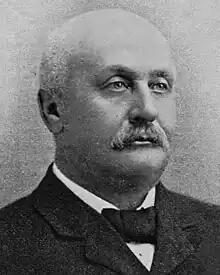 | 1885–1894 |
| 5 | Henry Richard Webb | 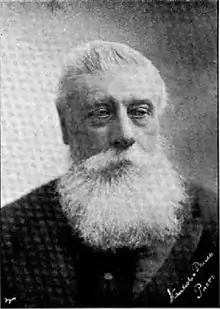 | 1894–1901 |
| 6 | Thomas S. Weston |  | 1901–1902 |
| 7 | Arthur Rhodes |  | 1902–1904 |
| 8 | Charles Lewis | .jpg.webp) | 1904–1907 |
| 9 | George Warren Russell |  | 1907–1910 |
| 10 | Jonathan Charles Adams[67] | 1910–1918 | |
| 11 | Henry Acland[68] |  | 1918–1928 |
| 12 | George John Smith | 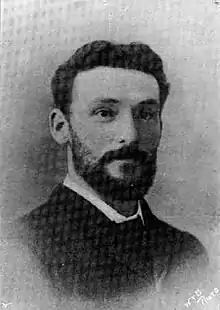 | 1928–1932 |
| 13 | Christopher Thomas Aschman[69] | .jpg.webp) | 1932–1933 |
| Chair of the Canterbury University College Council | |||
| 1 | Christopher Thomas Aschman | .jpg.webp) | 1933–1938 |
| 2 | Arthur Edward Flower[70] |  | 1938–1944 |
| 3 | John Henry Erle Schroder[71] | 1944–1946 | |
| 4 | Walter Cuthbert Colee | 1946–1948 | |
| 5 | Joseph Ward[72] | .jpg.webp) | 1948–1951 |
| 6 | William John Cartwright | 1951–1954 | |
| 7 | Donald William Bain | .jpg.webp) | 1954–1957 |
| Chancellor of the University of Canterbury | |||
| 1 | Donald William Bain | .jpg.webp) | 1957–1959 |
| 2 | Carleton Hunter Perkins | 1959–1965 | |
| 3 | Alwyn Warren | 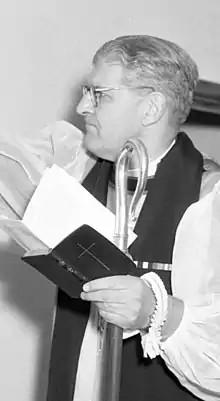 | 1965–1968 |
| 4 | Terry McCombs |  | 1968–1971 |
| 5 | John Matson | 1972–1976 | |
| 6 | Brian Anderson | 1977–1979 | |
| 7 | Jean Herbison[73] | 1979–1984 | |
| 8 | Charles Caldwell | 1984–1986 | |
| 9 | Richard Bowron | 1987–1991 | |
| 10 | Ian Leggat | 1992–1997 | |
| 11 | Phyllis Guthardt | 1998–2002 | |
| 12 | Robin Mann | 2003–2008 | |
| 13 | Rex Williams[60][74] | 2009–2012 | |
| 14 | John Wood[60] | 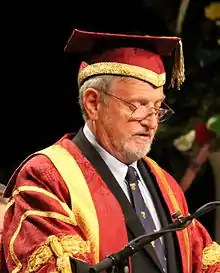 | 2012–2018 |
| 15 | Susan McCormack | 2019–2022 | |
| 16 | Amy Adams[75] | .jpg.webp) | 2022–present |
Campuses
The University of Canterbury has three campuses spread throughout the city of Christchurch:
- Ilam: The university has a main campus of 76 hectares (190 acres) at Ilam, a suburb of Christchurch about 5 kilometres (3.1 mi) from the centre of the city. The Ilam campus maintains three libraries with the Central Library (Māori: Te Puna Mātauraka o Waitaha) housed in the tallest building on campus, the 11-storey Puaka-James Hight building. The Ilam campus is where the Faculties of Education, Health, Science, Engineering, Business, Law and Arts are based. The University of Canterbury Students' Association is based there in the Haere roa building. The Ilam Campus is home to cafes and restaurants as well as a pharmacy, bookshop, the UC rec centre and the UC Health centre.
- Dovedale: The Dovedale Campus is 11 hectares (27 acres) and became a part of the University of Canterbury when the Christchurch College of Education (a specialist teacher training institution) merged on 1 January 2007.[76] The Dovedale campus is located adjacent to the Ilam campus and is off Dovedale avenue. The campus consists of the old Henry Field Library, The Christchurch College of English, Ilam early Learning Centre and Hayashi and Sonoda student residences. The Faculty of Education also maintains a presence here.
- City: The Christchurch City Campus is made up of the Christchurch Arts Centre and the Manawa building which is a part of the Faculty of Health. Music and classics are again taught from the Christchurch Arts Centre in the old chemistry building,[77] and within the new Manawa building in Christchurch city health and education are taught.[78] The city campus also includes the Teece Museum of Classical Antiquities – home of the James Logie Memorial Collection.
The university also maintains additional small campuses in Nelson, Tauranga and Timaru, and teaching centres in Greymouth, New Plymouth, Rotorua and Timaru. The university has staff in regional information offices in Nelson, Timaru, and Auckland.
Libraries
The UC Library was first established at Canterbury College in 1879. Today there are three libraries on campus each covering different subject areas.[79]

Central Library
The Central Library (Māori: Te Puna Mātauraka o Waitaha)[79] – is housed in the iconic Puaka-James Hight Building which is designed in the brutalist style architecture. In 1974, the old City campus library moved to the Ilam campus and was housed in the newly constructed James Hight building, originally named after former Canterbury professor James Hight.[80] The building was renamed Puaka-James Hight in 2014, after the brightest star in the cluster Matariki, to reflect the growing strength of UC's relationship with Ngāi Tahu and the mana of Te Ao Māori at the heart of the university's campus.[81] The University of Canterbury Central Library is the largest university library in New Zealand.[82] The Central Library has collections of over 2 million physical items including books, archives, journals and a miscellany of other items that support research and teaching in Humanities, Social Sciences, Law, Commerce, Music, Fine Arts and Antarctic Studies.[83]
- The Henry Field Library (named for the New Zealand Educationalist Henry Edward Field) on the old Christchurch College of Education site joined the fold when the university and Christchurch College of Education merged. However, the Education collection was incorporated into the collections within the Puaka-James Hight building, and Henry Field is now a library store at the campus off Dovedale Avenue.[84]
- A separate Law library was established within the James Hight building, it was then relocated to the new Law building (Mere Mere). However, after the 2011 Christchurch earthquake it returned to the Puaka-James Hight Building and integrated into the Central Library collection. The Mere Mere Building still operates as the Law and Business Building however it is no longer home to the law library.[84]
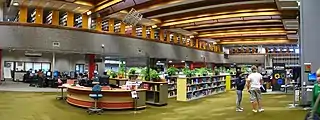
EPS Library
The EPS Library (Engineering and Physical Sciences Library, Māori: Kā Puna Pūkahataka me te Pūtaiao)[79] supports research and teaching in Engineering, Forestry and Sciences.[79] With the move to the Ilam campus, the Library was split. First the Engineering Library, and later the Physical Sciences Library, moving to the new campus however the old Physical Sciences Library closed and its collections moved to the Engineering Library now called the EPS Library.
Macmillian Brown Library
The Macmillan Brown Library (Māori: Te Puna Rakahau o Macmillan Brown)[79] is a research library, archive, and art gallery that specializes in collecting items related to New Zealand and Pacific Islands history.[85][86] It holds over 100,000 published items including books, audio-visual recordings, and various manuscripts, photographs, works of art, architectural drawings and ephemera. The Macmillan Brown Library's art collection also has over 5,000 works, making it one of the largest collections in the Canterbury Region.[87] Some notable items in its collections include copies of Māori Land Court Records, official and government documents from various Pacific Islands states, trade union records, and the personal papers of various Members of Parliament and government ministers. The library is named after John Macmillan Brown, a prominent Canterbury academic who helped found the library, allocated a large proportion of his fortune to the Macmillan Brown Library.[85][86]

Student accommodation
The university has ten student residences throughout its Ilam and Dovedale campuses: five fully-catered halls of residence exclusively for first-year undergraduate students: Arcady, College House, Rochester and Rutherford, Tupuānuku and University Hall; and five other self-catered student accommodation houses which are home to both undergraduate and postgraduate students: Sonoda Christchurch Campus, Hayashi, Kirkwood Avenue, Waimairi Village and Ilam Apartments. The largest, Ilam Apartments, houses 831 students during the academic year.[88] Some of the halls at UC have storied histories; Tupuānuku is named for the star of the same name that is connected to food grown in the ground in the cluster Matariki in Māori Mythology;[89] Rochester and Rutherford is named for former alumni Ernest Rutherford and John Fisher Bishop of Rochester; while Arcady, previously Bishop Julius Hall, was founded by the first Archbishop of New Zealand, Churchill Julius;[90] additionally, College House is the oldest residential college in New Zealand.[91][92]

Field facilities
The University of Canterbury has the most field stations of any New Zealand university.[93] The Field Facilities Centre[94] administers four of these field stations:
- Cass Field Station[95] – Provides a wide range of environments: montane grasslands, scrub, riverbed, scree, beech forest, swamp, bog, lake, stream and alpine habitats; all accessible by day trips on foot
- Harihari Field Station[96] – Access to native forests, streams
- Westport Field Station[97] – for study of the West Coast of New Zealand, particularly mining
- Kaikoura Field Station[98] – Kaikoura represents an important transition zone for flora and fauna, particularly in the marine environment, with Kowhai bush and associated rich bird life close by.
.jpg.webp)
The university and its project partners also operate an additional field station in the Nigerian Montane Forests Project;[99] this field station stands on the Ngel Nyaki forest edge in Nigeria.
The Department of Physical and Chemical Sciences runs its own field laboratories:
- Mount John University Observatory at Lake Tekapo for optical astronomical research[100]
- Birdlings Flat radar facility[101]
- Scott Base radar facility[102]
- Cracroft Caverns ring laser facility[103]
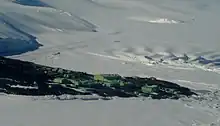
The Department of Physical and Chemical Sciences also has involvement in the Southern African Large Telescope[105] and is a member of the IceCube collaboration which is installing a neutrino telescope at the South Pole.[106][107]
Teece museum of classical antiquities
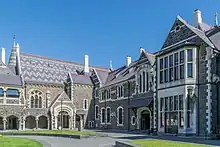
The University of Canterbury Teece Museum of Classical Antiquities opened in May 2017, and showcases the James Logie Memorial Collection, a collection of Greek, Roman, Egyptian and Near Eastern artefacts in New Zealand.[108] The Teece Museum is run as a part of the faculty of Arts. The museum is named for University of Canterbury Alumni Professor David Teece and his wife Leigh Teece, who donated a substantial amount of money to the city for earthquake recovery. The money was used by the university to install the classics and music school in the Old Chemistry building at the Christchurch Arts Centre.[109]
The James Logie Memorial Collection was established in 1957 as a result of Miss Marion Steven, a Classics faculty member, donating Greek pottery to Canterbury University College. Steven established the James Logie Memorial Collection to honour her husband, who served as registrar of the college from 1950 until his death in 1956.[110]
The Logie Collection includes a wide range of pottery, beginning with the Bronze Age cultures of Cyprus, Crete and Mycenae it also includes vases that come from Corinth and Athens, the islands in the Aegean, East Greece and the Greek colonies in South Italy and Sicily.[111]
Student culture

Students' Association
The University of Canterbury Students' Association (UCSA)[112] operates out of the Student Union Building named Haere-roa which serves as the main student activity centre. The original UCSA Building was damaged in the 2010 and 2011 earthquakes and was subsequently torn down, it was rebuilt and completed in 2019, it is located on the Ilam Campus. The building is home to two bars, "The Foundry" and "Bentleys". The Association also runs several cafes and restaurants around campus.[113] Located in Haere-roa is the Ngaio Marsh Theatre, named for the former alumnus of the same name. Haere-roa hosts a number of student societies and organization offices.
The university's student population operates the main student magazine, Canta, established in 1930. There are 12 issues per year, which are distributed around the UC campus every second Monday during the academic year.[114] The newspaper's offices are in the Haere-roa building. Canterbury's student population runs a radio station which began to broadcast and operate as RDU in 1976;[115] it began FM frequency broadcasting in 1986. RDU acquired its present frequency of 98.5 in 2003.
Orientation Week
Orientation Week or 'O. Week' is the Canterbury equivalent of student orientation, held in the first week of the academic year at the university. 'O. Week' is organised by the University of Canterbury Students' Association and involves events, including various concerts, a comedy night, clubs day and usually a Crusaders rugby game scheduled during the week.[116]
Clubs

The university has over 140 academic, sporting, recreational and cultural societies and clubs.[117] The most prominent of these include the Student Volunteer Army, the University of Canterbury Engineering Society (ENSOC), the University of Canterbury Law Society (LAWSOC), the University of Canterbury Commerce Society (UCOM) as well as the largest non-faculty clubs such as PongSoc (University of Canterbury Pong Society), Motosoc (Motorsports Society), Lads without Labels, CUBA (Canterbury University Boardriders' Association), CUTC (Tramping Club), UC Bike, Opsoc, The Gentlemen's Club. CUSSC (Canterbury University Snow Sports Club, formerly the CU Ski Club prior to 1997) is the only university club in New Zealand to own a ski field lodge, located at Temple Basin Ski Field.[118] The club runs many events to raise funds for maintenance of their lodge. The University of Canterbury Drama Society (Dramasoc) achieved fame for its 1942–1969 Shakespeare productions under Dame Ngaio Marsh, but regularly performs as an active student- and alumni-run arts fixture in the small Christchurch theatre-scene.
In 2011 the SVA was established in the aftermath of the Christchurch earthquakes. A student at the University of Canterbury, Sam Johnson, rallied fellow students to help support the clean-up from the devastation. The club has grown and today is the largest club at the University of Canterbury.[119] In 2020, in response to the COVID-19 pandemic, the SVA supported the vulnerable with their shopping during the lockdown.[120][121]
Lads without Labels is a not-for-profit charity dedicated to improving men's mental health in and around campus. On 5–8 October 2021 Lads without labels started the Project 72 fundraiser, a 72-hour relay on the University of Canterbury campus, which raised $12,000 for men's mental health; as well in 2021 Lads without labels organised a 24-hour backyard cricket marathon raising $45,000.[122]
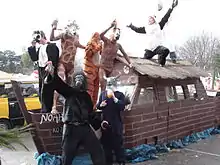
One major student tradition, the Undie 500, involved an annual car-rally from Christchurch to Dunedin run by ENSOC. The rules required only the use of a road-legal car costing under $500 with a sober driver.[123] The 2007 event gained international news coverage (including on CNN and BBC World) when it ended in rioting in the student quarter of Dunedin and in North East Valley. ENSOC cancelled the planned 2008 event. The Undie 500 was replaced by the Roundie 500 in 2011. This event has the same principles but follows a route through rural Canterbury, returning to Christchurch the same day.[124]
Academics
The University of Canterbury offers 147 undergraduate majors[125] and 61 graduate degrees.[126][127] For the 2020 academic year, the university granted 2,257 bachelor's degrees, 1,003 graduate degrees, and 384 honours degrees.[2] To graduate with a full-time undergraduate degree in the usual three years, undergraduates normally take four courses per semester. In most majors, an honors degree requires advanced coursework and a thesis – this usually takes an extra year. However, some undergraduate degrees that are also professional degrees, such as the Bachelor of Laws (LLB), Bachelor of Engineering (BEng) and Bachelor of Forestry Science (BForSc), typically take four years.
At the university, students may choose to study towards two bachelor's degrees in parallel and graduate. Working on two separate degrees at the same time – a double degree – allows you to finish some combinations in four to five years. The University of Canterbury also provides conjoint degree options, which combine two set degrees into a single bachelor's degree in four years of study. Conjoint degrees should not be confused with double majors, where students will earn a double major if their two majors lead to the same degree name and a double degree if their two majors lead to different degrees.[128]
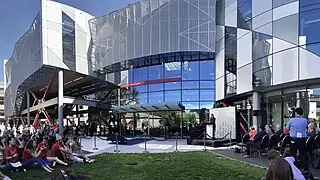
Size and composition
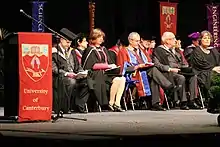
According to the UC Annual Report, at 31 December 2019 the university has a total of 18,364 students (14,891 equivalent full-time students). 11,621 of these are undergraduates, and 1,869 are international students. UC has a total of 826 academic faculty staff.[2]
Following the earthquakes, the number of students enrolled at UC fell from 18,783 during 2010 to 14,725 during 2014, though the number of new enrolments increased in 2014. In 2016 enrolled student numbers rose to 15,564.[30] Enrolment as of 2020 has reached pre-earthquake levels with a 18,364 students enrolled at UC.
Staff reductions and academic freedom issues
One resignation, which occurred in 2003, was by a staff member who complained about restrictions on academic freedom.[129][130] In 2006, New Zealand's Green Party suggested staff eliminations were based on the university's profit targets rather than merit.[131] The university eliminated over 100 jobs in 2010, the year prior to the earthquakes.[132]
In 2007, New Zealand universities including the University of Canterbury were accused of taking an increasingly litigious approach to managing its staff and, despite having an array of human-resources managers, routinely engaged lawyers and employment advocates to handle even minor matters.[133] The university's 2006 financial reports list $836,000 as having been paid out as compensation for employment-relationship problems.[133] However, in its 2013 annual report (two years after the 2011 Canterbury Earthquakes), it is stated that the university spent $4.66 million in 2012 and 2013 alone on expenses associated with faculty and staff layoffs (severance pay, legal costs, etc.).[134]
Supporting equity and diversity
In July 2019 the appointment of the role Rainbow Advisor provided support to the LGBTQ community. In 2020 the appointment of Darryn Russell was announced to manage a broader portfolio of Amokapua Pākākano | AVC Māori, Pacific & Equity.[135]
However, in 2014, one faculty member chosen to receive a teaching award from the University of Canterbury Students' Association refused to accept the award because of his concerns about student racism and sexism at UC.[136][137]
Rankings
| University rankings | |
|---|---|
| Global – Overall | |
| ARWU World[138] | 401–500 |
| QS World[139] | 258 |
| THE World[140] | 501–600 |
| National – Overall | |
| ARWU National[141] | 3–4 (2021) |
| CWUR National[142] | 3 (2022) |
In the 2017 Academic Ranking of World Universities (ARWU), UC was dropped completely from the world's top 500 universities.[138] In the 2017 QS World University Rankings, UC was rated 214th overall in the world, and third highest among New Zealand universities.[143][144] Its individual global faculty rankings for 2015/2016 were: 146th in Arts & Humanities, 161st in Engineering & IT, 211th in Natural Sciences, and 94th in Social Sciences and Management.[145] By 2018, these faculty rankings had all fallen considerably,[146] and as of the release of the 2019 world university rankings, the three major university ranking organisations, ARWU, QS and THE, had all placed UC squarely in the middle of the pack of NZ universities at fourth place overall out of eight institutions, and in one case just two numerical positions above NZ's fifth-place university in the nation's lower division.[147][148][149] In the 2016–2017 Times Higher Education World University Rankings, UC was ranked in the world's top 400 universities,[150] up from being in just the world's top 500 universities in 2015.[151][152] By 2021, however, UC had fallen back into just the top 600.[153] Similarly, ARWU dropped UC from the top 400 universities in 2018 to just the top 500 in 2019, where it has remained ever since.[138]
The university was the first in New Zealand to be granted five stars by QS Stars.[154][155] Unlike the QS World University rankings, QS Stars ratings are only given to universities that pay a fee; the programme is designed to give "those institutions that are not highly ranked or do not appear in the rankings an opportunity to reach out to their prospect students, to stand out and to be recognised for their excellence."[156][157]
| 2022 | 2021 | 2020 | 2019 | 2018 | 2017 | 2016 | 2015 | 2014 | 2013 | 2012 | 2011 | 2010 | 2009 | 2008 | 2007 | 2006 | |
|---|---|---|---|---|---|---|---|---|---|---|---|---|---|---|---|---|---|
| Academic Ranking of World Universities | 401–500th[158] | 401–500th[159] | 401–500th[158] | 401–500th[158] | DNQ: Ranked Below World's Top 500 Universities[160] | 401–500th[161] | 401–500th[162] | 401–500th[163] | 401–500th[164] | 401–500th[165] | |||||||
| QS World University Rankings | 258th[166] | 270th[167] | 231st[168] | 214th[169] | 214th=[170] | 211th[171] | 242nd[172] | 238th[173] | 221st[174] | 212nd[175] | 189th[176] | 188th[177] | 186th[177] | 188th[178] | 333rd[179] | 333rd[180] | |
| Times Higher Education World University Rankings | 501–600th[181] | 401–500th[153] | 351–400th[182] | 351–400th[183] | 351–400th[184] | 401–500th[152] | 301–350th[151] | 301–350th[185] | 301–350th[186] | 301–350th[187] |
Notable people
Alumni
Since it was founded, University of Canterbury alumni have made significant and creative contributions to society, the arts and sciences, business, national New Zealand, and international affairs. The University of Canterbury's alumni include four New Zealand Prime Ministers, the father of nuclear physics and the mathematician who discovered the exact solution to the Einstein field equations of general relativity.[188]
- Notable University of Canterbury alumni include:
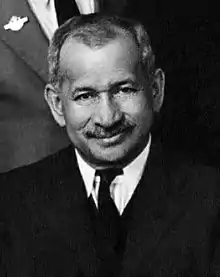 Āpirana Ngata, New Zealand Politician and Lawyer, first Māori to receive a degree.
Āpirana Ngata, New Zealand Politician and Lawyer, first Māori to receive a degree. Ernest Rutherford, awarded the Nobel Prize in Chemistry.
Ernest Rutherford, awarded the Nobel Prize in Chemistry..jpg.webp) Margaret Mahy, Author of children's and young adult books.
Margaret Mahy, Author of children's and young adult books.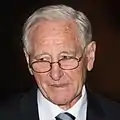 Roy Kerr, Mathematician who discovered the Kerr geometry.
Roy Kerr, Mathematician who discovered the Kerr geometry. John Key, 38th Prime Minister of New Zealand.
John Key, 38th Prime Minister of New Zealand.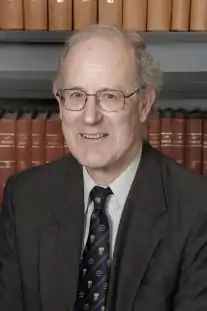 Andrew Tipping, Justice of the Supreme Court of New Zealand
Andrew Tipping, Justice of the Supreme Court of New Zealand.jpg.webp) Jenny Shipley, 36th Prime Minister of New Zealand.
Jenny Shipley, 36th Prime Minister of New Zealand.
- Rita Angus – painter
- Ian Axford – space scientist
- Michael Baigent – author and archaeologist
- Rosemary Banks – ambassador to the United Nations
- David Beauchamp – civil engineer
- Rex Bergstrom – academic and economist
- Don Brash – former Governor of the Reserve Bank of New Zealand and former leader of the opposition
- Althea Carbon – lawyer and co-founder of Charity-IT
- Eleanor Catton – writer and Man Booker Prize winner 2013
- Neil Cherry – environmental scientist
- Mark Chignell – academic
- Nathan Cohen – world champion and Olympic champion rower
- Judith Collins – politician and former leader of the National Party
- Michael P. Collins – academic
- Helen Connon – educational pioneer
- Michael Cullen – former deputy prime minister and minister of finance
- Lianne Dalziel – 46th mayor of Christchurch[189]
- Rhys Darby – comedian
- G. F. J. Dart – headmaster of Ballarat Grammar School 1942–1970
- Peter Dunne – politician
- Brian Easton – economist
- Atta Elayyan – futsal player, murdered in the Christchurch mosque shootings[190]
- Stevan Eldred-Grigg – historian and novelist
- Ian Foster – computer scientist
- Rob Fyfe – businessman and former Air New Zealand CEO
- Edith Searle Grossmann – writer and journalist
- Henry Hargreaves – photographer
- Rhona Haszard – artist
- Joel Hayward – academic
- Toby Hendy – science communicator
- Ken Henry – Secretary to the Treasury (Australia)
- Rodney Hide – politician
- Jock Hobbs – former captain of the All Blacks
- Marian Hobbs – politician
- Catherine Isaac – politician
- Bruce Jesson – writer
- Jess Johnson – artist
- Roger Kerr – executive director of the New Zealand Business Roundtable
- Roy Kerr – mathematician and physicist, discovered the Kerr geometry
- John Key – 38th prime minister of New Zealand
- Howard Kippenberger, military leader
- Jordan Luck – musician
- Christopher Luxon – leader of the National Party and former CEO of Air New Zealand
- Euan Macleod – painter
- Margaret Mahy – author of children's and young adult books[189]
- Ngaio Marsh – crime writer and theatre director
- Julie Maxton – academic administrator
- John McMillan – economist
- Colleen Mills – communications professor
- Trevor Moffitt – painter
- Mike Moore – 34th prime minister of New Zealand and director-general of the World Trade Organisation
- Stuart Nash – politician
- Sam Neill – actor
- Craig Nevill-Manning – engineer
- Sir Āpirana Ngata – lawyer and statesman; first Māori person to complete a degree at a New Zealand university
- William Orange – Anglican churchman and founder of Latimer House
- Graham Panckhurst – High Court Judge
- Thomas Paulay – earthquake engineer
- Bill Pickering – engineering administrator
- J. G. A. Pocock – historian
- Nigel Priestley – earthquake engineer
- Kieran Read – former captain of the All Blacks[191]
- Ivor Richardson – president of the Court of Appeal of New Zealand
- Ruth Richardson – lawyer and former minister of finance
- Michelle Rogan-Finnemore — geologist, legal expert, Antarctic program manager
- Bill Rowling – 30th prime minister of New Zealand
- Theia (singer) – musician
- Ernest Rutherford – physicist and Nobel laureate in chemistry[192]
- Graham Cecil Scott, CB – economist, government official, international consultant
- Feleti Vakaʻuta Sevele – 14th prime minister of Tonga
- Jenny Shipley – 36th prime minister of New Zealand[193]
- Nick Smith – politician
- Kevin Smith – actor
- John Storey – rower
- Margaret Thomson – film director
- Beatrice Tinsley – astronomer
- Sir Andrew Tipping – former Justice of the Supreme Court of New Zealand
- Anote Tong – 4th president of Kiribati[189]
- Vincent Ward – film director and screenwriter
- Ada Wells – feminist
- Murray C. Wells – professor of accounting at the University of Sydney
- Dora Wilcox – poet
- Nicola Willis – politician
- Cal Wilson – comedian and television personality
- Glenn Wilson – psychologist
- John Young – professor of composition, De Montfort University, Leicester
- William Young – Justice of the Supreme Court of New Zealand[189]
Faculty
- Alexander Bickerton – chemist
- Anne-Marie Brady – political scientist
- Alice Candy – historian
- Denis Dutton – philosopher
- Jan Evans-Freeman – electrical engineer
- Juliet Gerrard – biochemist
- Clive Granger – Nobel Memorial Prize in Economic Sciences, Erskine Fellow
- Robert Grubbs – Nobel Memorial Prize in Chemistry, Erskine Fellow
- Elizabeth Herriott – botanist and first woman appointed lecturer
- Susan Krumdieck – energy transition engineering
- Henrietta Mondry – specialist in Russian culture
- Karl Popper – philosopher
- Arthur Prior – philosopher
- Duncan Webb – Politician and Lawyer
Honorary doctors
Since 1962, the University of Canterbury has been awarding honorary doctorates. In many years, no awards were made, but in most years, multiple doctorates were awarded. The highest number of honorary doctorates was awarded in 1973, when there were seven recipients.[194]
Popular culture
Film
- Heavenly Creatures (1994) Based on the Parker–Hulme murder case, Juliet Hulme (later known as Anne Perry) was the daughter of Henry Hulme, the rector of the University of Canterbury, and she and Pauline Parker murdered Honorah Parker, Pauline's mother. During this period Juliet and her family lived on campus in the Ilam homestead (now the University of Canterbury Staff Club), where filming for the movie took place.[195]
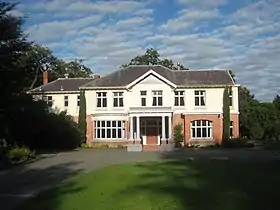 The Ilam Homestead, home of the University of Canterbury Staff Club. The home of Juliet Hulme, during the 1950s.
The Ilam Homestead, home of the University of Canterbury Staff Club. The home of Juliet Hulme, during the 1950s.
References
- "Endowments at Te Whare Wānanga o Waitaha The University of Canterbury" (PDF). Retrieved 1 December 2022.
- "University of Canterbury Annual Report 2019" (PDF). Archived (PDF) from the original on 18 June 2020. Retrieved 14 February 2021.
- "Visual Identity & Brand Guidelines". Archived from the original on 18 May 2021. Retrieved 18 May 2021.
- "Ngāi Tahu Research Centre". Archived from the original on 18 May 2021. Retrieved 18 May 2021.
- "Crusaders". Archived from the original on 20 May 2021. Retrieved 20 May 2021.
- "The Star 04-05-17". issuu. Archived from the original on 18 October 2021. Retrieved 12 May 2017.
- "Shanghai Ranking-Universities". www.shanghairanking.com. Archived from the original on 25 July 2021. Retrieved 25 July 2021.
- "Oldest Universities in New Zealand | by foundation year". www.4icu.org. Archived from the original on 9 July 2021. Retrieved 6 July 2021.
- Gardner, W. J., Beardsley, E. T., & Carter, T. E. (1973). Christchurch: University of Canterbury.
- "History and chronology". The University of Canterbury. Retrieved 6 March 2022.
- "Our History". College House 2021. Retrieved 7 March 2022.
- "History at Canterbury". University of Canterbury. Archived from the original on 24 October 2016. Retrieved 21 July 2021.
- "The Story of New Zealand Universities". Archived from the original on 6 August 2014. Retrieved 4 August 2014.
- "History Lincoln University". Lincoln.ac.nz. Archived from the original on 11 June 2018. Retrieved 8 June 2018.
- "History of the Coat of Arms". University of Canterbury. Archived from the original on 18 May 2017. Retrieved 8 June 2017.
- "Our vision » The Arts Centre". www.artscentre.org.nz. Archived from the original on 25 January 2021. Retrieved 26 January 2021.
- "1974 – Christchurch". www.insidethegames.biz. Retrieved 7 March 2022.
- "2007 Merger". Canterbury University. Canterbury University. Archived from the original on 21 June 2017. Retrieved 20 June 2017.
- "Christchurch earthquake – latest news". Stuff. 28 February 2011. Retrieved 7 March 2022.
- "NEW ZEALAND: Universities closed by earthquake". University World News. Retrieved 7 March 2022.
- "22 February 2011 Canterbury earthquake for kids". Christchurch City Council Libraries.
- "New Zealand universities cut staff and courses". Archived from the original on 3 July 2013. Retrieved 30 September 2011.
- Law, Tina (4 October 2011). "Canterbury Uni invites staff to resign". The Press. Archived from the original on 6 December 2011. Retrieved 26 November 2011.
- "Canterbury crumbles as enrolments decline". The Australian. Australian Associated Press. 4 October 2011. Archived from the original on 4 October 2011. Retrieved 26 November 2011.
- Law, Tina (28 September 2011). "Two uni buildings for demolition". The Press. Archived from the original on 30 November 2011. Retrieved 26 November 2011.
- "Canterbury University a 'ghost-town'". The Press. 11 May 2013. Archived from the original on 6 March 2014. Retrieved 6 October 2013.
- Brook, Kip (13 May 2013). "Record number of PhD students enrolled at UC". University of Canterbury. Archived from the original on 6 March 2014. Retrieved 6 October 2013.
- "NZ unis warned not to poach from Chch". Television New Zealand. NZN. 16 September 2011. Archived from the original on 10 June 2015. Retrieved 14 September 2015.
- "Govt to provide $260m to University of Canterbury rebuild". The Beehive. Archived from the original on 26 August 2017. Retrieved 1 June 2017.
- "Annual reports | Leadership and Governance | University of Canterbury". The University of Canterbury. Archived from the original on 5 May 2017. Retrieved 12 May 2017.
- "Canterbury universities begin bounce back after earthquakes". Stuff. 2 March 2016. Archived from the original on 26 August 2017. Retrieved 1 June 2017.
- "University of Canterbury's 30-year plan to create 'little city inside a larger city'". Stuff. 23 January 2017. Archived from the original on 26 August 2017. Retrieved 1 June 2017.
- Gardner et al 1973, p. 451.
- "The University Council – Overview". University of Canterbury. Archived from the original on 3 November 2013. Retrieved 7 October 2013.
- "University of Canterbury Charter 2003–2010" (PDF). 24 December 2003. p. 14. Archived (PDF) from the original on 3 November 2013. Retrieved 7 October 2013.
- "Canterbury College School of Engineering Lab". Archived from the original on 25 July 2021. Retrieved 25 July 2021.
- "Christchurch College of Education (CCE) New Zealand". Archived from the original on 25 July 2021. Retrieved 25 July 2021.
- "The Canterbury College Ordinance, 1873". Wellington: Victoria University of Wellington Library. Archived from the original on 6 March 2014. Retrieved 6 October 2013.
- Gardner et al 1973, pp. 38–39.
- Gardner et al 1973, p. 39.
- Gardner et al 1973, p. 452.
- Scholefield 1940a, p. 118.
- "Obituary". The Press. Vol. XL, no. 5998. 3 December 1884. p. 3. Archived from the original on 29 March 2014. Retrieved 6 October 2013.
- Cyclopedia Company Limited (1902). "The Rev. James Buller". The Cyclopedia of New Zealand : Canterbury Provincial District. Christchurch: The Cyclopedia of New Zealand. Archived from the original on 10 June 2015. Retrieved 6 October 2013.
- Scholefield 1940a, p. 179.
- Scholefield 1940a, pp. 231f.
- Scholefield 1940a, pp. 311f.
- Scholefield 1940a, pp. 322f.
- Scholefield 1940a, p. 426.
- Scholefield 1940a, p. 459.
- "Mr A. C. Knight". The Press. Vol. LXII, no. 12377. 16 December 1905. p. 12. Archived from the original on 29 March 2014. Retrieved 6 October 2013.
- Scholefield 1940b, pp. 74f.
- Scholefield 1940b, p. 404.
- "Obituary". The Star. No. 4400. 1 June 1882. p. 4. Archived from the original on 29 March 2014. Retrieved 6 October 2013.
- "University News – Communications and Development – University of Canterbury". Comsdev.canterbury.ac.nz. 11 February 2003. Archived from the original on 9 February 2013. Retrieved 10 September 2010.
- "Tertiary Education Commission". Tertiary Education Commission. Archived from the original on 29 January 2013. Retrieved 10 September 2010.
- Colman, Jeanette, ed. (9 May 2008). "Sharp named new chief executive of Tertiary Education Commission" (PDF). Chronicle. 43 (7): 1. Archived from the original (PDF) on 9 February 2013. Retrieved 6 October 2013.
- "TEC appoints new Chief Executive" (Press release). Tertiary Education Commission. 2 May 2008. Archived from the original on 13 February 2009. Retrieved 6 October 2013.
- "University News – Communications and Development – University of Canterbury – New Zealand". Comsdev.canterbury.ac.nz. 15 October 2008. Archived from the original on 8 February 2013. Retrieved 10 September 2010.
- "University of Canterbury announces new Chancellor" (Press release). University of Canterbury. 2 December 2011. Archived from the original on 9 March 2014. Retrieved 7 October 2013.
- "University of Canterbury appoints Cheryl de la Rey as Vice-Chancellor". Stuff. 11 June 2018. Archived from the original on 25 July 2021. Retrieved 25 July 2021.
- "Senior partner retires from Christchurch firm to lead top university". www.thelawyermag.com. Archived from the original on 25 July 2021. Retrieved 25 July 2021.
- Gardner et al 1973, pp. 451–452.
- "Chronology". University of Canterbury. Archived from the original on 16 October 2013. Retrieved 11 October 2013.
- "The Late Hon. H. B. Gresson". The Press. Vol. LVIII, no. 10882. 5 February 1901. p. 6. Archived from the original on 30 March 2014. Retrieved 7 October 2013.
- Scholefield 1940b, pp. 47f.
- Cyclopedia Company Limited (1903). "Primary Schools". The Cyclopedia of New Zealand : Canterbury Provincial District. Christchurch: The Cyclopedia of New Zealand. Archived from the original on 6 March 2014. Retrieved 7 October 2013.
- "Obituary". The Evening Post. Vol. CXXXIV, no. 143. 14 December 1942. p. 3. Archived from the original on 13 June 2015. Retrieved 7 October 2013.
- Gardner et al 1973, p. 178.
- Gardner et al 1973, p. 192.
- Gardner et al 1973, p. 183.
- Gardner et al 1973, p. 279.
- Falconer, Phoebe (26 May 2007). "Obituary: Dame Jean Herbison". The New Zealand Herald. Archived from the original on 16 October 2013. Retrieved 28 January 2013.
- "About the Commissioners". Canterbury Regional Council. 7 May 2010. Archived from the original on 10 June 2015. Retrieved 7 October 2013.
- Kenny, Lee (2 March 2022). "Former MP Amy Adams named as new chancellor of University of Canterbury". Stuff. Retrieved 2 March 2022.
- "Mergers of Colleges of Education approved". The Beehive. Archived from the original on 26 July 2021. Retrieved 25 July 2021.
- "Student life returns to Christchurch's Arts Centre". University of Canterbury. Archived from the original on 7 August 2020. Retrieved 26 July 2020.
- "'To better serve the community': Health precinct buildings officially open". Stuff. 31 January 2019. Archived from the original on 1 August 2020. Retrieved 26 July 2020.
- Library Locations Archived 7 April 2014 at the Wayback Machine University of Canterbury. Retrieved on 21 February 2018
- James Hight Library & Arts Tower Archived 7 April 2014 at the Wayback Machine University of Canterbury. Retrieved on 6 April 2014
- James Hight is now Puaka-James Hight Archived 16 January 2017 at the Wayback Machine UC student blog. Retrieved on 14 January 2016
- "James Hight Library – Information and Records Management – University of Canterbury – New Zealand". www.canterbury.ac.nz. Archived from the original on 6 May 2021. Retrieved 20 June 2021.
- "History of the UC library | About the library | Libraries | UC Library". The University of Canterbury. Archived from the original on 24 June 2021. Retrieved 20 June 2021.
- "History of the UC library | About the library | Libraries | UC Library". The University of Canterbury. Archived from the original on 24 June 2021. Retrieved 6 July 2021.
- History of the Macmillan Brown Library Archived 7 April 2014 at the Wayback Machine University of Canterbury. Retrieved on 6 April 2014
- Heritage Collections Archived 7 April 2014 at the Wayback Machine University of Canterbury. Retrieved on 6 April 2014
- "The Macmillan Brown Library document" (PDF). Archived from the original (PDF) on 5 May 2013.
- "Ilam Apartments". The University of Canterbury. Archived from the original on 16 August 2021. Retrieved 13 October 2021.
- "Tupuanuku & Tupuarangi". InMotion Matariki Parade. Archived from the original on 7 February 2021. Retrieved 13 October 2021.
- Taonga, New Zealand Ministry for Culture and Heritage Te Manatu. "Julius, Churchill". teara.govt.nz. Archived from the original on 7 March 2021. Retrieved 13 October 2021.
- "College House History". Archived from the original on 10 October 2007. Retrieved 25 July 2021.
- "New Zealand: University of Canterbury (Outgoing Program)". Archived from the original on 25 July 2021. Retrieved 25 July 2021.
- "Other Projects – Learning Resources – University of Canterbury – New Zealand". Canterbury.ac.nz. Archived from the original on 26 August 2017. Retrieved 12 May 2017.
- "Field Facilities Centre – University of Canterbury – New Zealand". Ffc.canterbury.ac.nz. Archived from the original on 19 January 2013. Retrieved 10 September 2010.
- "Cass Field Station – Field Facilities Centre – University of Canterbury – New Zealand". Ffc.canterbury.ac.nz. Archived from the original on 17 March 2013. Retrieved 10 September 2010.
- "Harihari Field Station – Field Facilities Centre – University of Canterbury – New Zealand". Ffc.canterbury.ac.nz. Archived from the original on 17 March 2013. Retrieved 10 September 2010.
- "Westport Field Station – Field Facilities Centre – University of Canterbury – New Zealand". Ffc.canterbury.ac.nz. Archived from the original on 17 March 2013. Retrieved 10 September 2010.
- "Kaikoura Field Station – Field Facilities Centre – University of Canterbury – New Zealand". Ffc.canterbury.ac.nz. Archived from the original on 6 April 2017. Retrieved 12 May 2017.
- "Nigerian Montane Forest Project – Biological Sciences – University of Canterbury – New Zealand". Biol.canterbury.ac.nz. Archived from the original on 12 December 2012. Retrieved 10 September 2010.
- Mt John – Physics and Astronomy – University of Canterbury – New Zealand Archived 17 May 2011 at the Wayback Machine. Phys.canterbury.ac.nz. Retrieved on 17 August 2013.
- Birdlings Flat – Physics and Astronomy – University of Canterbury – New Zealand Archived 29 October 2017 at the Wayback Machine. Phys.canterbury.ac.nz. Retrieved on 17 August 2013.
- Atmospheric Physics Group Field Stations Archived 17 March 2013 at the Wayback Machine. .phys.canterbury.ac.nz (22 August 2008). Retrieved on 17 August 2013.
- "Ring Laser Project Webpage". 3 July 2014. Archived from the original on 3 July 2014. Retrieved 18 June 2015.
- "Antarctic Studies". The University of Canterbury. Archived from the original on 9 July 2021. Retrieved 5 July 2021.
- SALT – Physics and Astronomy – University of Canterbury – New Zealand Archived 1 May 2013 at the Wayback Machine. Phys.canterbury.ac.nz. Retrieved on 17 August 2013.
- Research – Physics and Astronomy – University of Canterbury – New Zealand Archived 26 August 2013 at the Wayback Machine. Phys.canterbury.ac.nz. Retrieved on 17 August 2013.
- IceCube Neutrino Observatory Archived 12 January 2015 at the Wayback Machine. Icecube.wisc.edu. Retrieved on 17 August 2013.
- Gates, Charlie (7 November 2021). "The low-profile museum in a Gothic courtyard full of ancient wonders". Stuff. Retrieved 11 April 2022.
- Redmond, Adele (16 May 2017). "40-year homecoming as University of Canterbury returns music and classics students to Arts Centre". Stuff. Retrieved 11 April 2022.
- Wiltshire, Roswyn (30 June 2021). "Marion Steven and the Logie Collection". The Journal of New Zealand Studies (NS32). doi:10.26686/jnzs.iNS32.6866. ISSN 2324-3740. S2CID 237762690.
- Green, J.R. (2007). Greek and Roman Treasures in Christchurch. Canterbury University Press.
- "The University of Canterbury Students' Association". UCSA. Archived from the original on 23 January 2013. Retrieved 10 September 2010.
- — University of Canterbury Students' Association Archived 13 May 2013 at the Wayback Machine. Ucsa.org.nz. Retrieved on 17 August 2013.
- "About". CANTA. 30 March 2017. Archived from the original on 20 May 2021. Retrieved 13 October 2021.
- "HISTORY OF 'U' 1975 RDU". 13 April 2017. Archived from the original on 13 April 2017. Retrieved 13 October 2021.
- "Orientation". UCSA. Archived from the original on 20 May 2021. Retrieved 20 May 2021.
- Clubs — University of Canterbury Students' Association Archived 15 May 2013 at the Wayback Machine. Ucsa.org.nz. Retrieved on 17 August 2013.
- "History – Temple Basin Ski Area". Retrieved 11 November 2021.
- "Our Story". Student Volunteer Army. Archived from the original on 27 July 2020. Retrieved 26 July 2020.
- "Coronavirus: Student Volunteer Army rallies help with childcare and shopping". Stuff. Archived from the original on 29 March 2020. Retrieved 29 March 2020.
- "Ōtautahi Christchurch Leading the Way in Helping Elderly and Vulnerable". Archived from the original on 26 July 2020. Retrieved 2 April 2020.
- "The fundraising fanatic who never fails to find 'stuff' to do". Stuff. 27 October 2021. Retrieved 11 November 2021.
- "Undie 500". Otago Daily Times Online News. Retrieved 11 November 2021.
- Fitzgerald, Chelle (1 March 2020). "Students, start your engines: A short history of the Undie 500". The Spinoff. Retrieved 11 November 2021.
- "Subjects". The University of Canterbury. Archived from the original on 11 August 2021. Retrieved 19 July 2021.
- "Master's degrees | Qualifications and courses". The University of Canterbury. Archived from the original on 11 July 2021. Retrieved 19 July 2021.
- "PhDs and doctoral degrees | Qualifications and courses". The University of Canterbury. Archived from the original on 10 July 2021. Retrieved 19 July 2021.
- "Double and conjoint degrees | Qualifications and courses". The University of Canterbury. Archived from the original on 11 July 2021. Retrieved 20 July 2021.
- NEW ZEALAND: Academic freedom Archived 16 October 2013 at the Wayback Machine. Wais.stanford.edu. Retrieved on 17 August 2013.
- Fudge1 Archived 24 March 2012 at the Wayback Machine. Adelaideinstitute.org. Retrieved on 17 August 2013.
- "Don't sack Canterbury academics – Greens – Scoop News". Scoop.co.nz. Archived from the original on 23 October 2013. Retrieved 22 January 2017.
- New Zealand universities cut staff and courses – World Socialist Web Site Archived 27 November 2011 at the Wayback Machine. Wsws.org (8 September 2011). Retrieved on 17 August 2013.
- AUS Tertiary Update | Scoop News Archived 2 May 2013 at the Wayback Machine. Scoop.co.nz (11 October 2007). Retrieved on 17 August 2013.
- "University of Canterbury 2013 Annual Report" (PDF). Archived (PDF) from the original on 13 February 2016. Retrieved 15 May 2016.
- "UC's rainbow community celebrates Pride Week". University of Canterbury. Archived from the original on 27 July 2020. Retrieved 26 July 2020.
- "University of Canterbury lecturer returns award over racism". 3 News. 9 October 2014. Archived from the original on 25 October 2014. Retrieved 25 October 2014.
- Veer, Ekant (7 October 2014). "Why I Returned My 2014 Lecturer of the Year (College of Business and Law) Award". Archived from the original on 10 October 2014. Retrieved 21 October 2014.
- "University of Canterbury – Academic Ranking of World Universities – 2017 – Shanghai Ranking – 2017". Shanghairanking.com. Archived from the original on 12 June 2018. Retrieved 8 June 2018.
- "University of Canterbury". Topuniversities.com. 16 July 2015. Archived from the original on 12 June 2018. Retrieved 8 June 2018.
- "University of Canterbury". Times Higher Education (THE). Archived from the original on 3 September 2021. Retrieved 3 September 2021.
- "ShanghaiRanking's Academic Ranking of World Universities". www.shanghairanking.com. Retrieved 28 February 2022.
- "Best Universities in New Zealand in 2021–2022 | CWUR". cwur.org. Retrieved 28 February 2022.
- "QS World University Rankings 2016". 25 August 2016. Archived from the original on 16 November 2017. Retrieved 29 September 2016.
- Field, Michael (2 June 2011). "NZ universities sliding down world league". Stuff. Archived from the original on 24 September 2015. Retrieved 18 June 2015.
- "QS World University Rankings by Faculty". Topuniversities.com. Archived from the original on 26 January 2017. Retrieved 22 January 2017.
- "QS World University Rankings by Subject 2018". Topuniversities.com. Archived from the original on 18 October 2021. Retrieved 8 June 2018.
- "World University Rankings – 2017 – New Zealand Universities in Top 500 universities – Academic Ranking of World Universities – 2017 – Shanghai Ranking – 2017". Shanghairanking.com. Archived from the original on 17 June 2018. Retrieved 8 June 2018.
- "QS World University Rankings 2019". Topuniversities.com. 29 May 2018. Archived from the original on 9 June 2017. Retrieved 8 June 2018.
- "World University Rankings". Times Higher Education (THE). 26 September 2018. Archived from the original on 26 September 2018. Retrieved 30 December 2020.
- "World University Rankings". 17 August 2016. Archived from the original on 22 September 2016. Retrieved 29 September 2016.
- "World University Rankings". Times Higher Education. October 2014. Archived from the original on 25 July 2018. Retrieved 25 October 2015.
- "World University Rankings". Times Higher Education. 30 September 2015. Archived from the original on 4 October 2015. Retrieved 25 October 2015.
- "World University Rankings". Times Higher Education (THE). 25 August 2020. Archived from the original on 18 May 2018. Retrieved 17 May 2018.
- "UC receives international 5-star rating", 23 September 2011, canterbury.ac.nz
- "Canterbury University gets top marks". The Press. 30 September 2011. Archived from the original on 5 December 2011. Retrieved 26 November 2011.
- "Selos de Qualidade no Ensino Superior" (PDF). Aep.tecnico.ulisboa.pt. Archived (PDF) from the original on 20 December 2016. Retrieved 22 January 2017.
- Jobbins, David (25 July 2012). "QS defends paid-for gold star addition to rankings". University World News. Archived from the original on 20 December 2016. Retrieved 22 January 2017.
- "Academic Ranking of World Universities". Academic Ranking of World Universities 2010. Shanghai Ranking Consultancy. Archived from the original on 25 July 2021. Retrieved 25 July 2021.
- "University of Canterbury | Academic Ranking of World Universities – 2020 | Shanghai Ranking – 2020". www.shanghairanking.com. Archived from the original on 23 May 2017. Retrieved 12 May 2017.
- "Academic Ranking of World Universities". Academic Ranking of World Universities 2015. Shanghai Ranking Consultancy. Archived from the original on 30 October 2015. Retrieved 25 October 2015.
- "Academic Ranking of World Universities". Academic Ranking of World Universities 2014. Shanghai Ranking Consultancy. Archived from the original on 19 January 2015.
- "Academic Ranking of World Universities". Academic Ranking of World Universities 2013. Shanghai Ranking Consultancy. Archived from the original on 11 March 2019. Retrieved 26 October 2015.
- "Academic Ranking of World Universities". Academic Ranking of World Universities 2012. Shanghai Ranking Consultancy. Archived from the original on 5 April 2013. Retrieved 26 October 2015.
- "Academic Ranking of World Universities". Academic Ranking of World Universities 2011. Shanghai Ranking Consultancy. Archived from the original on 30 May 2012. Retrieved 26 October 2015.
- "Academic Ranking of World Universities". Academic Ranking of World Universities 2010. Shanghai Ranking Consultancy. Archived from the original on 10 December 2015. Retrieved 26 October 2015.
- "University of Canterbury". Top Universities. 16 July 2015. Archived from the original on 18 May 2018. Retrieved 17 May 2018.
- "University of Canterbury | Te Whare Wānanga o Waitaha". Top Universities. Archived from the original on 24 June 2021. Retrieved 19 June 2021.
- "University of Canterbury". Topuniversities.com. 16 July 2015. Archived from the original on 12 June 2018. Retrieved 8 June 2018.
- "QS World University Rankings 2018". Top Universities. 5 June 2017. Archived from the original on 9 June 2017. Retrieved 7 June 2017.
- "QS World University Rankings 2016". Top Universities. 25 August 2016. Archived from the original on 6 March 2017. Retrieved 12 May 2017.
- "QS World University Rankings® 2015/16". Archived from the original on 14 September 2015. Retrieved 9 April 2016.
- "QS World University Rankings® 2014/15". Archived from the original on 16 March 2018. Retrieved 23 September 2014.
- "QS World University Rankings 2013". Archived from the original on 21 October 2016. Retrieved 23 September 2014.
- "QS Top Universities 2012". Archived from the original on 13 September 2012. Retrieved 29 October 2012.
- "QS Top Universities 2011". Archived from the original on 30 September 2011. Retrieved 14 September 2011.
- "QS Top Universities 2010". Archived from the original on 16 September 2010. Retrieved 14 September 2010.
- All Study Destinations Archived 22 January 2012 at the Wayback Machine. Top Universities. Retrieved on 17 August 2013.
- "QS World University Rankings 2007". THES. Archived from the original on 30 November 2010. Retrieved 14 September 2010.
- "QS World University Rankings 2006". THES. Archived from the original on 30 November 2010. Retrieved 14 September 2010.
- "QS World University Rankings 2005". THES. Archived from the original on 1 December 2010. Retrieved 14 September 2010.
- "World University Rankings". Times Higher Education (THE). 3 September 2021. Archived from the original on 18 May 2018. Retrieved 17 May 2018.
- "World University Rankings". Times Higher Education (THE). 20 August 2019. Archived from the original on 18 September 2019. Retrieved 10 June 2020.
- "World University Rankings". Timeshighereducation.com. 18 August 2017. Archived from the original on 6 September 2017. Retrieved 8 June 2018.
- "World University Rankings". Times Higher Education (THE). 17 August 2016. Archived from the original on 22 September 2016. Retrieved 12 May 2017.
- "World University Rankings". Times Higher Education. 13 April 2015. Archived from the original on 30 May 2015. Retrieved 26 October 2015.
- "University of Canterbury – The Times Higher University Rankings 2012–2013". Archived from the original on 7 October 2012. Retrieved 29 October 2012.
- "Top 400 – The Times Higher University Rankings 2011–2012". Archived from the original on 7 October 2011. Retrieved 5 October 2011.
- "Our alumni". The University of Canterbury. Archived from the original on 14 May 2021. Retrieved 15 October 2021.
- "William Young". The University of Canterbury. Archived from the original on 24 June 2021. Retrieved 19 June 2021.
- Day, James (16 March 2019). "Former Corvallis man killed in New Zealand terror attacks". Gazette Times. Archived from the original on 17 March 2019. Retrieved 18 March 2019.
- "Kieran Read's thoughts on leadership and values". The University of Canterbury. Archived from the original on 24 June 2021. Retrieved 19 June 2021.
- "Ernest Rutherford". The University of Canterbury. Archived from the original on 24 June 2021. Retrieved 19 June 2021.
- "Jennifer Shipley | Biography & Facts". Encyclopedia Britannica. Archived from the original on 6 June 2021. Retrieved 19 June 2021.
- "Honorary Graduates" (PDF). University of Canterbury. Archived from the original (PDF) on 4 March 2015. Retrieved 14 June 2014.
- Gates, Charlie (17 April 2014). "Heavenly Creatures locations 20 years on". Stuff. Retrieved 13 March 2022.
Sources
- Gardner, W. Jim; Beardsley, E. T.; Carter, T. E. (1973). Phillips, Neville Crompton (ed.). A History of the University of Canterbury, 1873–1973. Christchurch: University of Canterbury.
- Hight, J., Candy, A. M. F., & Canterbury College. (1927). A short history of the Canterbury College (University of New Zealand): With a register of graduates and associates of the college. Whitcombe and Tombs.
- Scholefield, Guy, ed. (1940a). A Dictionary of New Zealand Biography : A–L (PDF). Vol. I. Wellington: Department of Internal Affairs. Retrieved 6 October 2013.
- Scholefield, Guy, ed. (1940b). A Dictionary of New Zealand Biography : M–Addenda (PDF). Vol. II. Wellington: Department of Internal Affairs.
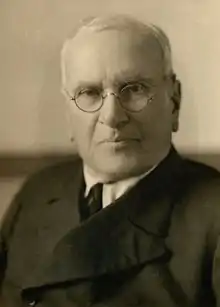
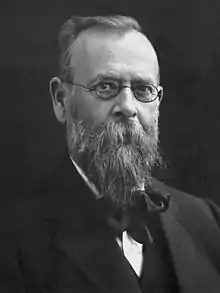
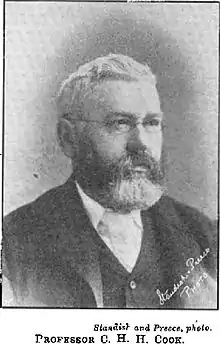
.jpg.webp)
